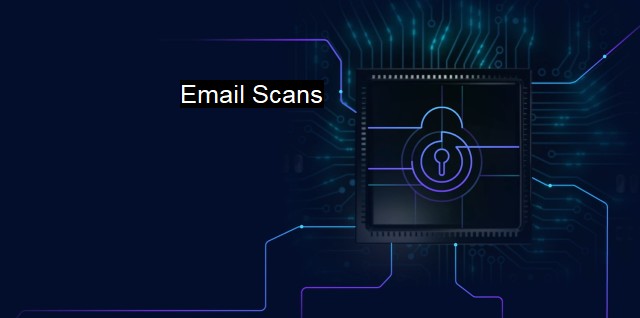What are Email Scans?
Email Scans: A Vital Tool in Strengthening Cybersecurity and Combating Malicious Attacks
Email scans, situated in the expansive context of cybersecurity and antivirus, refer to comprehensive procedures conducted to inspect all incoming and outgoing email communications to isolate and mitigate any potential threats that can compromise systems security. Today, email scanning is increasingly vital given that email is a popular medium for cyberattacks, often used to infiltrate corporate networks to carry out harmful actions such as deploying malware, phishing attempts, carrying out business email compromise (BEC) scams, and even advanced persistent threats (APTs)Predominantly, email scans focus on incoming email messages as these are the messages that pose the most common threat. These scans check for malicious codes such as viruses, worms, or Trojans that may be hidden within the email or its attachments. Cyber attackers often utilize email attachments or embedded links leading to malicious websites as tools to compromise systems. Consequently, email scanning software scrutinizes attachments and links, ensuring they are safe for the user and free of damaging entities.
An essential aspect of email scans lies in the capability to identify phishing emails. This technique used by cybercriminals in efforts to trick recipients into revealing sensitive information? – personal data, financial information, login credentials, or security details. As a part of the scanning process, software systems analyze the email context, sender authenticity, embedded links' legitimacy, and suspicious patterns to identify and filter out phishing mails that trojans, keyloggers, or ransomware could potentially exploit.
Perhaps less prominent though still significant are outbound email scans. Supporting cybersecurity on several levels, these can prevent the leak of sensitive information, stop a machine (which may unknowingly be part of a botnet) from spreading malware, and also keep the organization’s IP address from being blacklisted for sending out spam or malware.
Email scans are integrated into a body of solutions known as Email Security Gateways (ESG). These deploy multiple layers of protection including, but not limited to, spam filters, fraud protection, secure email gateways, and email encryption. Assembly of such a many-layered protective shield makes the process of breaching an organization’s email security significantly more complex and thus helps in more robust protection.
Integrating AI and machine learning algorithms into the scanning process serves to perfect the mechanism of detection. By continually learning from every processed email and the patterns it contains, the system improves, catching not only known threats but also continually adapting to identify new, evolving threats. This application of technology greatly enhances email scanning performance, refining its capacity to isolate and limit damaging attempts at cyber penetration.
The direct fallout of email scans is in containing, mitigating, and preventing widespread damage in an incredibly interconnected digital world. If a potential threat makes way past the initial email barrier, it may have catastrophic consequences, costing parties sizeable economic damages and reputation blemishes, not mentioning possible legal implications for neglecting data privacy regulations.
Despite the advancement of other platforms of communications like instant messaging, social media, and online forums, email remains pertinent to both personal and professional communications. Consequently, it is continuously targeted by these potentially disastrous cyber malpractices due to the abundance of information it holds, making email scans a non-negotiable asset in optimal cybersecurity practice.
It is safe to appreciate that while email scans alone may not guarantee foolproof cybersecurity, they form an integral line of defense against cybercrimes in the diverse cyber ecosystem. email scanning is only a part of the holistic approach necessary for cybersecurity as users need to take up other steps as well, such as secure password policies, regular patching and updates, and end-user education and awareness. With this comprehensive, layered approach, is the most robust path to safeguarding individual users, businesses, and whole industries in our increasingly interconnected, and inevitably vulnerable digital world.

Email Scans FAQs
What is an email scan?
An email scan is a cybersecurity process that involves scanning email messages and attachments for potential threats, such as viruses, malware, and phishing attempts. This process helps to ensure that the email is safe and secure for the recipient to open and interact with.Why is email scanning important for cybersecurity?
Email scanning is important for cybersecurity because email is one of the most common ways for cybercriminals to distribute malware, ransomware, and other types of threats. By scanning emails for potential threats, cybersecurity measures work to keep both individuals and organizations safe from cyber attacks.Can email scanning prevent all cyber threats?
While email scanning is an important cybersecurity measure, it cannot prevent all cyber threats. Cybercriminals are constantly evolving their tactics, and new threats may not be detected by email scanning software right away. It is important to use multiple layers of cybersecurity measures to stay protected from cyber threats.What should I do if my email scan detects a threat?
If your email scan detects a threat, it is important to avoid opening the email or any attachments that may be infected. Notify your IT department immediately so that they can take appropriate action, which may include blocking the sender, quarantining the email, or removing the threat from your system.| | A | | | B | | | C | | | D | | | E | | | F | | | G | | | H | | | I | | | J | | | K | | | L | | | M | |
| | N | | | O | | | P | | | Q | | | R | | | S | | | T | | | U | | | V | | | W | | | X | | | Y | | | Z | |
| | 1 | | | 2 | | | 3 | | | 4 | | | 7 | | | 8 | | |||||||